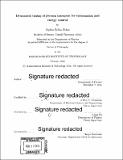Dynamical tuning of phonon transport for information and energy control
Author(s)
Sklan, Sophia Robin
DownloadFull printable version (20.17Mb)
Other Contributors
Massachusetts Institute of Technology. Department of Physics.
Advisor
Jeffrey C. Grossman and Liang Fu.
Terms of use
Metadata
Show full item recordAbstract
Controlled transport of energy and information is of paramount importance. It remains challenging, however, partially from the difficulty in controlling their physical carriers. Steering electrons and photons is now routine, yet atomic vibrations (quantized as phonons) are hard to control. This is partly due to the centrality of phonons in the disordered transport of energy as heat, but even in ordered sound waves problems persist. Phonons can readily couple to each other or to other degrees of freedom, degrading their energy or information content. Reversing these couplings, thereby regulating atomic motion, only recently became plausible. This increased control would reduce parasitic losses and turn phonons into information carriers. Dynamical effects are a crucial and under-examined aspect of this control as static devices are insufficient for changing external conditions. Dynamical control adds flexibility and versatility to phononic systems. Essentially, dynamical control requires tunable materials, materials whose physical properties depend on an external signal. Dynamical tuning is sensitive to the relative frequencies of the tuning signal and the controlled phonons. We develop an intuitive framework of the temporal modulation regimes. In low frequency tuning, phonons can adapt adiabatically to the material's changes. A variety of signals can be temporally and spatially modulated to tune phonon transport in this regime. We apply this adiabatic perspective to analyze dynamical effects in thermal cloaks. Tuning signals near the frequency of some phonon mode can produce resonant couplings. This hybridization can produce large changes in phonon properties. We apply this hybridization to develop a rigorously nonreciprocal phononic computer using magneto-acoustic materials that can outperform conventional computers in some tasks. At high frequencies, phonons can only respond perturbatively to the tuning signal's changes. This regime is generally limited to optical control but it opens up new avenues for control. Employing an alternative approach to optical coupling, we develop a model of inverse acousto-optics (tuning the speed of sound with optical intensity) and dynamical phonon localization.
Description
Thesis: Ph. D., Massachusetts Institute of Technology, Department of Physics, 2016. Cataloged from PDF version of thesis. Includes bibliographical references (pages 145-164).
Date issued
2016Department
Massachusetts Institute of Technology. Department of PhysicsPublisher
Massachusetts Institute of Technology
Keywords
Physics.